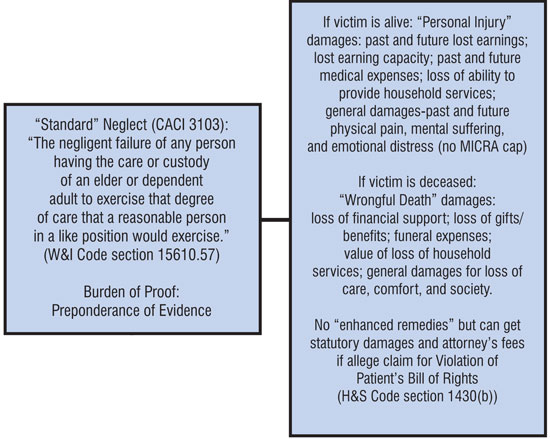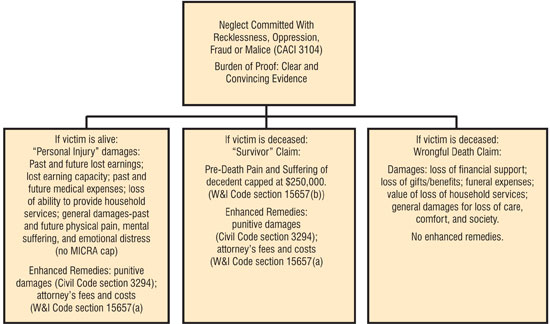Available damages in elder-abuse cases
Understanding the economic and general damages recoverable for elder abuse, as well as the “enhanced remedies”
In order to maximize recovery in cases involving the abuse or neglect of an elderly or dependent adult (“elder-abuse cases”), it is important to understand the specific damages that are available. The damages available are dependent primarily on whether the plaintiff can adequately plead and prove that the defendant’s actionable conduct was done with recklessness, oppression, fraud or malice, and whether the victim is alive or deceased. The following is a summary of the damages available in these cases in California. Also, attached to this article is a flow chart that summarizes the available damages.
Pursuant to Welfare & Institutions Code section 15610.57, neglect means, “The negligent failure of any person having the care or custody of an elder or a dependent adult to exercise that degree of care that a reasonable person in a like position would exercise.”
Under the statute, neglect includes, but is not limited to, the following:
- Failure to assist in personal hygiene or in the provision of food, clothing or shelter;
- Failure to provide medical care for physical and mental health needs;
- Failure to protect from health and safety hazards; or
- Failure to prevent malnutrition or dehydration.
Physical abuse is defined by Welfare & Institutions Code section 15610.63 and includes assault, battery, assault with a deadly weapon, force likely to produce great bodily injury, unreasonable physical constraint or prolonged or continual deprivation of food or water, sexual assault, and sexual battery.
Personal-injury damages
In all elder-abuse cases, living plaintiffs are entitled to the same damages as other personal-injury victims. These damages include the following:
- Past and future lost earnings;
- Lost earning capacity;
- Past and future medical expenses;
- Loss of ability to provide household services; and
- General damages including past and future physical pain, mental suffering, and emotional distress.
In addition, a plaintiff’s spouse can also sue and recover damages for loss of consortium.
Furthermore, if a family member witnessed the abuse or neglect, and suffered emotional distress as a result, claims for “negligent infliction of emotional distress” on their behalf may be available and should be considered.
These compensatory damages in elder-abuse cases are not subject to the restrictions of the Medical Injury Compensation Reform Act (“MICRA”).
“Enhanced remedies” and punitive damages
In addition to these compensatory damages, “enhanced remedies” are available if the plaintiff can prove, by clear and convincing evidence, that the defendant is liable for abuse or neglect and that the defendant has been guilty of recklessness, oppression, fraud or malice in the commission of the abuse/neglect. (See CACI 3104.) These “enhanced remedies” include attorney’s fees and costs. (See Welf. & Inst. Code, § 15657(a).) Furthermore, unlike most personal-injury actions where a plaintiff’s right to recover damages for pain and suffering is lost upon that plaintiff’s death, in elder-abuse cases, the victim’s pre-death pain and suffering is recoverable to the survivors of the deceased as one of these “enhanced remedies.” However, such a pain and suffering award is limited to a maximum recovery of $250,000. (See Welf. & Inst. Code, § 15657(b).)
Since the elements of punitive damages are nearly identical to those elements required to recover the “enhanced remedies” under the elder-abuse statutes, punitive damages should be sought whenever a defendant’s conduct is oppressive, fraudulent or malicious. There is no specific procedural requirement in alleging punitive damages in these cases. As the provisions of MICRA are not applicable, nor is section 425.13 of the Code of Civil Procedure.
In cases where the victim is deceased, claims based on both “survival” and wrongful death should be asserted. As discussed previously, damages for the pre-death pain and suffering of a decedent who was the victim of abuse or neglect committed with recklessness, oppression, fraud or malice are recoverable by the decedent’s survivor up to $250,000. In addition, the attorney’s fees and costs discussed above are also recoverable as an “enhanced remedy” even when the victim is deceased.
Wrongful death
A deceased victim’s heirs also have standing to bring claims for wrongful death. Damages for these wrongful death claims based on the abuse/neglect of an elder or dependent adult include the following:
- Loss of financial support;
- Loss of gifts/benefits;
- Funeral expenses;
- Loss of value of household services; and
- General damages including loss of care, comfort, and society.
In addition to the compensatory and enhanced remedies available as damages as set forth above, an often-overlooked avenue of additional damages in elder-abuse cases against a skilled nursing facility is the allegation of a claim for “Violation of Patient’s Bill of Rights” pursuant to Health & Safety Code section 1430, subdivision (b). A violation of this section permits a plaintiff to recover statutory damages and attorney’s fees and costs.
In sum, in evaluating elder-abuse cases, it is imperative to recognize the specific damages that are available, and the requirements to plead and prove each of them. The “enhanced remedies” that are available are effective tools to maximize the recovery for victims of abuse and neglect. But even in cases where recklessness, malice, oppression or fraud cannot be proven, the potential damages can be significant.
Louanne Masry

Louanne Masry is an attorney at Taylor & Ring in Los Angeles. In addition to litigating general negligence cases, her specialties include elder abuse and sexual abuse cases. She has been honored as a California Super Lawyer. (www.taylorring.com)
Copyright ©
2026
by the author.
For reprint permission, contact the publisher: Advocate Magazine


